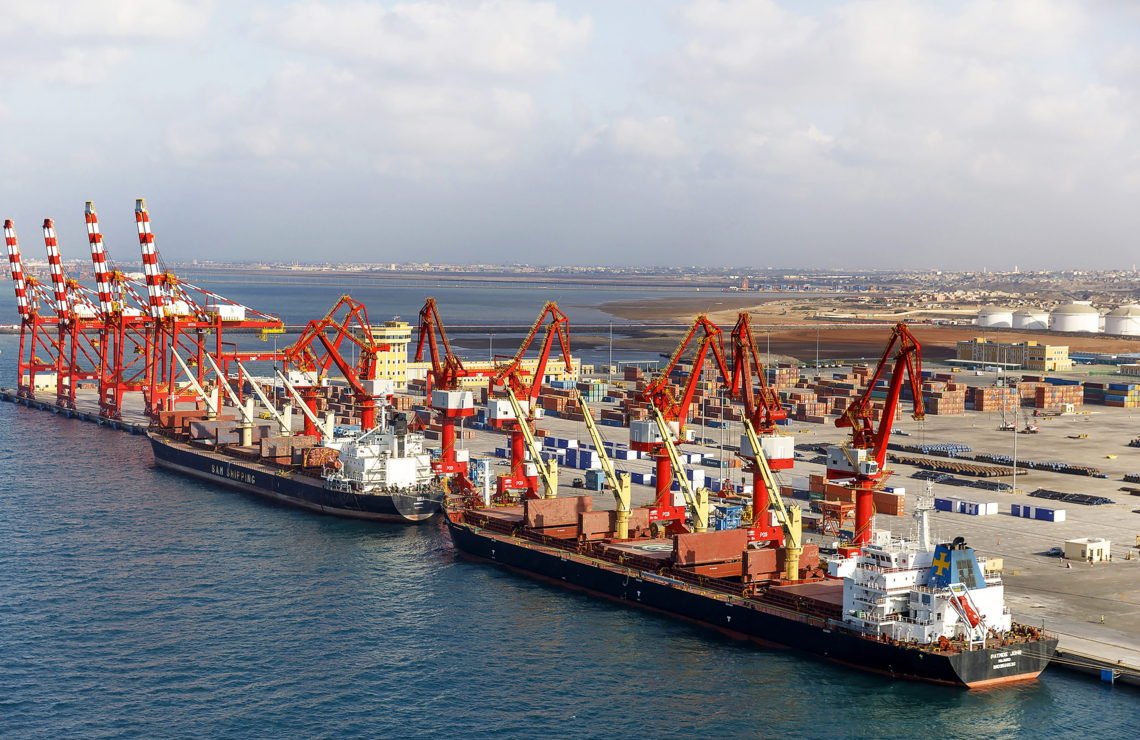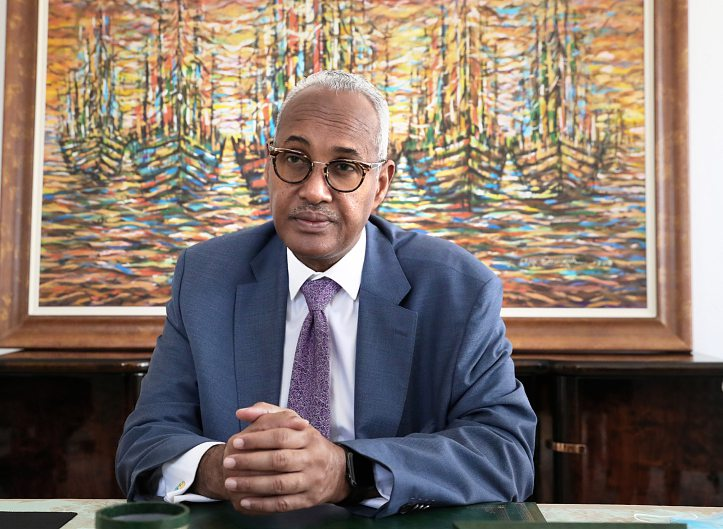
Djibouti or the adaptation strategy
From the Covid-19 pandemic and instability in Ethiopia to the war in Ukraine and tensions in the Red Sea, the country's port terminals are dealing with a complex new situation. However, the investment and diversification strategy that the country has been pursuing for several years is helping to cushion the blow while also taking the long view.
While 20% of the world's seaborne trade and a million barrels of crude oil used to pass through the Bab el-Mandeb Strait on a daily basis, by early 2024 this traffic had halved, according to the International Monetary Fund (IMF).
Since last December, the world's largest shipping companies, including CMA CGM, Maersk, Cosco, MSC and Hapag-Lloyd, have no longer used this route, which has become a ‘ battleground ’ for the Iranian-backed Houthi militias from Yemen, who have no qualms about attacking ships and capturing crews. Companies now prefer the Cape of Good Hope. According to ocean and air freight rate benchmarking and market analytics platform Xeneta, this longer route results in additional fuel costs of up to a million dollars for a return trip between Asia and Northern Europe, despite saving around $400,000 to $700,000 on Suez Canal tolls. Transporting a 40-foot container now costs 6,000 dollars (compared with 3,000 dollars previously).

In Djibouti, where the shock of the Suez Canal closure in 1967 is still etched in people's memories, the impact of these disruptions on port activity is not being given much thought. Although trade declined by 20% at the start of the year, it has not collapsed. On the contrary, it is holding up well.
In fact, certain laws are implacable: although volumes are dropping, 90% of Ethiopian freight still transits through its quays, and 37% of the goods handled on the quays are destined for Ethiopia every year.
“Whatever happens, Djibouti remains a gateway to Ethiopia, a country with a population of over 120 million, which needs to feed itself, equip itself... Traffic is not just going to disappear. It's also a gateway to COMESA, a market of almost 400 million people”, says Khalil Chiat, financial adviser to Aboubaker Omar Hadi, Chairman of the Djibouti Port and Free Zone Authority (DPFZA). The port also enjoyed an excellent year in 2023, with traffic up 31% in September, boosted by the improved security situation in Ethiopia.
Transhipment as a solution
However, the fall in local and transit traffic has been offset by a significant increase in transhipment, which has increased twenty-fold, as Aboubaker Omar Hadi indicated in March. In mid-May, on the Bloomberg website, he predicted that the port's revenues would increase by a third compared with 2023, rising from $450 million to $600 million. “One man's misfortune is another man's business,” he said at the time. The biggest ships come to unload their cargo, which is picked up by smaller vessels supplying neighbouring ports. Like a prediction of things to come. In the medium term, the port plans to generate 50% of its business from transhipment, to reduce its dependence on transit traffic to Ethiopia and associated regional uncertainties. According to the Financial Times, in late January, the Strait even saw small and opportunistic Chinese companies offering their services between Doraleh, Jeddah, Aden, Aqaba and Sokhna and Chinese ports, taking advantage of a tacit immunity pact with the Houthis, something that had already been seen during Covid.
For a time, the Strait was used by ships that were unable to cross the Red Sea and came to unload cargo awaiting reshipment. Djibouti was also used as a substitute port for goods that could no longer reach Eritrea or Sudan, which were in the midst of conflict. While Djibouti authorised several ships from the European security mission Aspides (which is supposed to protect merchant ships in the Red Sea) to refuel and use its facilities, several ships hit by Houthi missiles were able to undergo repairs in Djibouti.
For forwarding agents, the port of Djibouti, like other ports in the region, has to contend with reduced availability of ships and much higher freight costs and insurance premiums.
However, these temporary setbacks have not prevented the Group from investing in its port and logistics infrastructure, as part of its long-term multimodal strategy. In late January, it inaugurated an extension to the Doraleh container terminal built on five hectares of land reclaimed from the sea, and took delivery of four new 135-metre high gantry cranes. This $70 million project will allow the port to accommodate larger ships, reduce port turnaround times and better respond to demand from the Ethiopian market.

These investments are paying off. According to a ranking drawn up by the World Bank and S&P Global Market Intelligence in 2023, which assesses the efficiency of port hubs according to the time between the arrival of a ship at the port and its departure after cargo exchange, the Doraleh terminal ranks as the third most efficient port in Africa for handling containers (26th in the world), behind Tangiers and Port Said, and just ahead of Berbera (144th in the world), Conakry and Dakar. In another report, published last January, the World Bank praised Djibouti's performance in recent years, ranking it 79th in 2023 (out of 160 countries) on the Logistics Performance Index (i.e. the ease with which it is possible to establish reliable connections between supply chains and border control), up from 134th place in 2016. And while the country has suffered from the successive impacts of Covid-19, the war in Ukraine, the rise in the cost of raw materials and the Ethiopian conflict, the port must today continue to diversify its activities, as the same report emphasises, in order to absorb all the shocks. “Together, the free zone, imports into our country and transhipment activities represent 70% of the traffic passing through our ports. The other 30% represents traffic destined for Ethiopia”, explained Aboubaker Omar Hadi on the Afrique Magazine website in January.
This is what is beginning to happen with the three new ports inaugurated in 2017, such as the port of Tadjourah, designed to export potash from Tigray, Ghoubet, which specialises in salt, and the Doraleh multimodal platform (DMP), which handles containers as well as bulk goods (wheat, fertilisers) and vehicles. It can accommodate ships carrying more than 15,000 containers and handle up to 9 million tonnes of goods a year.
In addition to the neighbouring free zone, also built by China Merchants, designed for local processing of products or for finishing the assembly of semi-assembled components and exporting them to Ethiopia or Europe, the diversification of activities has continued across the board with the creation of a national shipowner in 2017, Djibouti Shipping Company, which currently has two vessels and handles transhipment to neighbouring ports as well as to Turkey. There is also the Damerjog petrochemical complex, currently DPFZA's biggest ongoing project, and the development of services for ships, such as bunkering, making Djibouti an essential ‘petrol station’ for ships in the Red Sea, and ship repair, through a huge ‘marine garage’.
Highly visible from the capital's city centre, where it is currently anchored in the waters of the historic port, the 217-metre-long floating dock, which the Dutch company Damen Shipyards began building in 2020 and which is dedicated to ship repair, was inaugurated last July. With a lifting capacity of over 20,000 tonnes, the barge, which was built in Romanian shipyards but finished in Djibouti, will be able to handle commercial and military vessels weighing up to 50,000 tonnes. At a cost of more than $110 million, it is expected to create 3,000 local jobs. It will eventually reach the quays of the Damerjog terminals.
Efficiency and competitiveness
The days when port activities were limited to import-export traffic with Ethiopia along the quays of the historic Djibouti port, built by the French in 1888, are long gone. To generate new sources of revenue, and again relying on its key geographical position and the return of peace and stability to the region, the Port Authority plans to spend $350 million transforming the port into a business and upmarket residential centre, completing China Merchants' Port-Park-City strategy. There are also plans to strengthen the air-sea cargo model, and to undertake the development of the road network along the corridors. International donor funds are now pouring in to develop access routes to Ethiopia that will eventually compete with each other. The corridor linking Djibouti to Addis Ababa will have to compete with the one running from Berbera via Hargeisa in Somaliland, as well as the one running from the Kenyan port of Lamu, whose final destination is southern Sudan.
In mid-May, the latter, inaugurated in 2021, received its first shipment of 60,000 tonnes of fertiliser destined for neighbouring Ethiopia. To reduce the energy costs of its ports and free trade zones and make them self-sufficient in electricity supply, its financial arm, Great Horn Investment Holding (GHIH), 40% owned by the Djibouti Sovereign Wealth Fund and present in 23 companies, has also invested in two projects. In June 2023, it signed a contract with the Moroccan energy fund Neo Themis for the construction of two solar power plants (15 MW), a desalination plant and an LNG storage site in the free trade zones, before inaugurating the Red Sea Power wind farm (60 MW) in Ghoubet in September, in which it has co-invested alongside the Africa Finance Corporation (AFC) fund.
This should make its port even more efficient and competitive, even though it has repeatedly received complaints from Ethiopia about the high cost of its services, which cost $320 for a twenty-foot container ( including handling, unloading and loading onto trucks or trains), while the cost of road transport on the Djibouti-Ethiopia corridor averages $2,400.
Quick to respond to this criticism, Aboubaker Omar Hadi pointed out the high documentation fees charged by Ethiopian freight forwarders, who handle 98% of the traffic on the corridor between the two countries. ‘The Djibouti freight forwarder's documentation costs $60 per container, while the Ethiopian freight forwarder's documentation costs are $250’, explained the head of the Port Authority.
The other reason for the Port Authority's efforts to diversify its income is that this year it has accumulated $30 million in arrears with its neighbours. However, these controversies cloud neither the quality of relations between the two countries, which were enshrined in a strategic use agreement in 2002 nor the mutual benefits they bring to each other.
Djibouti authorised several ships from the European Aspides security to refuel and use its facilities. The days when port activities were limited to import-export traffic with Ethiopia along the quays of the historic Djibouti port are long gone.
|
RwandAir joins the sea-air strategy RwandAir began its first cargo flights between Kigali and Djibouti on 15 May, as part of the sea-air logistics model, which covers 21 countries and 24 cities, and aims to reroute and break up cargo received by ship and transiting through free trade zones. While Djibouti has held a plot of land near the Kigali special economic zone since 2016, Rwanda has had 20 hectares of land at the port of Djibouti, allocated to it in 2013. In November 2021, Ethiopian Airlines carried out its first air-sea freight operation from Djibouti, transporting 17 tonnes of electronic and household appliances from Shenzhen to Lagos and Kano in Nigeria. This air-sea freight project is twice as fast as sea transport alone and half the cost of air transport alone, the company pointed out. ‘This combination saves at least 8 hours by air and 5 days by sea, because Djibouti is on the sea route, unlike Dubai, for example, most of whose flights to Africa pass over Djibouti’, confirmed Aboubaker Omar Hadi. 
|